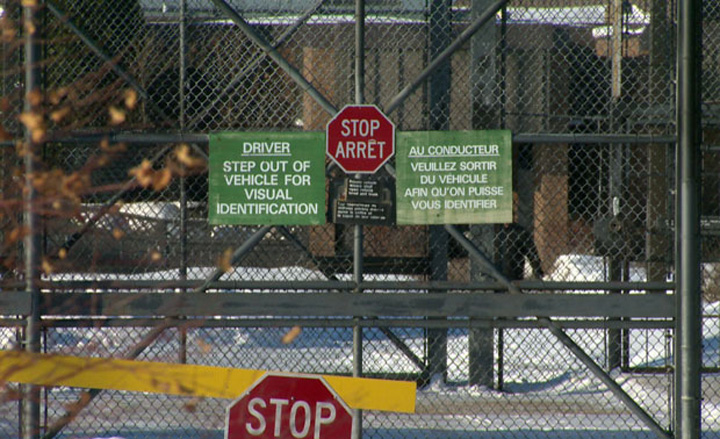Update: a judge’s ruling late Thursday afternoon determine Marlene Carter is not a dangerous offender. Read the story here.

Marlene Carter is sick.
The 43-year-old’s compulsion to hurt herself is so great she’ll hurl herself, against restraints, to smack her head against whatever hard surface is closest. She spent so much time in restraints her muscles atrophied, leaving her unable to stand on her own.
Thursday afternoon, a judge will decide whether Carter poses such a danger to the public she should be kept behind bars for the rest of her life.
Carter’s spent the past five years in Saskatoon’s Regional Psychiatric Centre – the deadliest and most violent federal prison in Canada, a Global News investigation revealed. And the same prison where Kinew James died last year.
IN DEPTH: Death Behind Bars
For much of those five years, Carter has been under Intensive Psychiatric Care – what’s supposed to be a short-term designation for inmates needing what her lawyer Jim Scott calls “a reset.” It can be beneficial, her lawyer says, for short periods and if accompanied by, well, intensive psychiatric care.
But in Carter’s case, her lawyer says, it meant years spending 23 hours a day in a solitary concrete cell with no access to direct light. She was restrained – tied down either to a wooden plank, a chair or, eventually, a special restraining bed – for so long she lost track of time, lost control of her withered muscles.
READ MORE: For some mentally ill inmates, solitary confinement by another name
Carter actually finished serving her initial sentence, for assault, in December 2011. She’s technically been on remand since then for two additional assault charges laid while in prison: Days after arriving at prison, she was in handcuffed in the exercise yard when she knelt and began to eat dirt off the ground. One hand slipped out of her handcuffs and when a prison guard moved to fix it, she swung at him with her still-cuffed hand. That led to a charge of assault with a weapon. So did an incident later when she threw hot water at a nurse while restrained in a chair in her cell.
Carter pleaded guilty, although Elizabeth Fry Society head Kim Pate wonders how she could be convicted on those charges if she was considered mentally incapable at the time. “How on earth could she have been found competent to assault someone?”
These two charges could lead to Carter being locked up for life. She finds out Thursday afternoon if she’s been designated a dangerous offender, which often means an indefinite sentence – decades spent under the same conditions that go against the advice of just about every health professional who’s had the chance to assess her.
When Pate first met Carter in 2011, she says, “the head of psychiatry at the time asked us to intervene because his recommendations about her mental health treatment were not being followed because security considerations were given precedent over her mental health issues.”
One of the health professionals who’s assessed Carter was Dr. AG Ahmed, who worked at the Saskatoon prison years ago but now heads up Brockville, Ont.’s, Secure Treatment Unit. Designed especially for the most mentally ill inmates, it’s meant to be a hospital first, and a prison second. It’s been demonstrated to work and, after years of lobbying from its proponents (including Tory Senator Bob Runciman), federal Public Safety Minister Steven Blaney announced a year-long “pilot project” for two women inmates with mental illness.
Carter would seem to fit the bill. And almost a month after Blaney’s announcement, Ahmed approached Carter’s lawyer Jim Scott, saying he wanted to take her in at the Brockville institution, “but his supervisor had concerns that there wasn’t financing in place.”
“Due to the Privacy Act and because the matter is currently before the courts, Correctional Service Canada (CSC) cannot discuss the specifics of this case,” spokesperson Sara Parkes said in an email late Thursday afternoon.
“Within CSC, each region has a Treatment Centre that provides intensive interdisciplinary treatment to federal offenders with mental and physical health care needs in safe and supportive environments.”
When Global News last asked why the promised pilot project has been stalled, spokesperson Sara Parkes said the May 1 announcement “highlighted an agreement in principle.”
“CSC is in the final stages of the negotiations of the terms of the pilot project and expecting a resolution soon,” she wrote in an email.
In Ahmed’s words, Carter’s lawyer recalls, “her environment was a pathogen”: It’s making her sicker, making recovery difficult, if not impossible.
Carter’s had such a multitude of diagnoses her lawyer’s reluctant to elucidate them.
“The bottom line is that there is some hope that with proper treatment she could be have a much higher quality of life than she’s having now,” Scott said. “It’s a prison. … It’s not the ideal environment for someone with mental illness.”
Canada’s dangerous offender designation is designed “to protect all Canadians from the most dangerous violent and sexual offenders in the country.”
“The big question that everybody should be asking,” Pate says, “Is, ‘On what basis would we consider her a risk to public safety? The argument for putting her in jail for longer, which is the place where these issues arose, is ludicrous.”





Comments